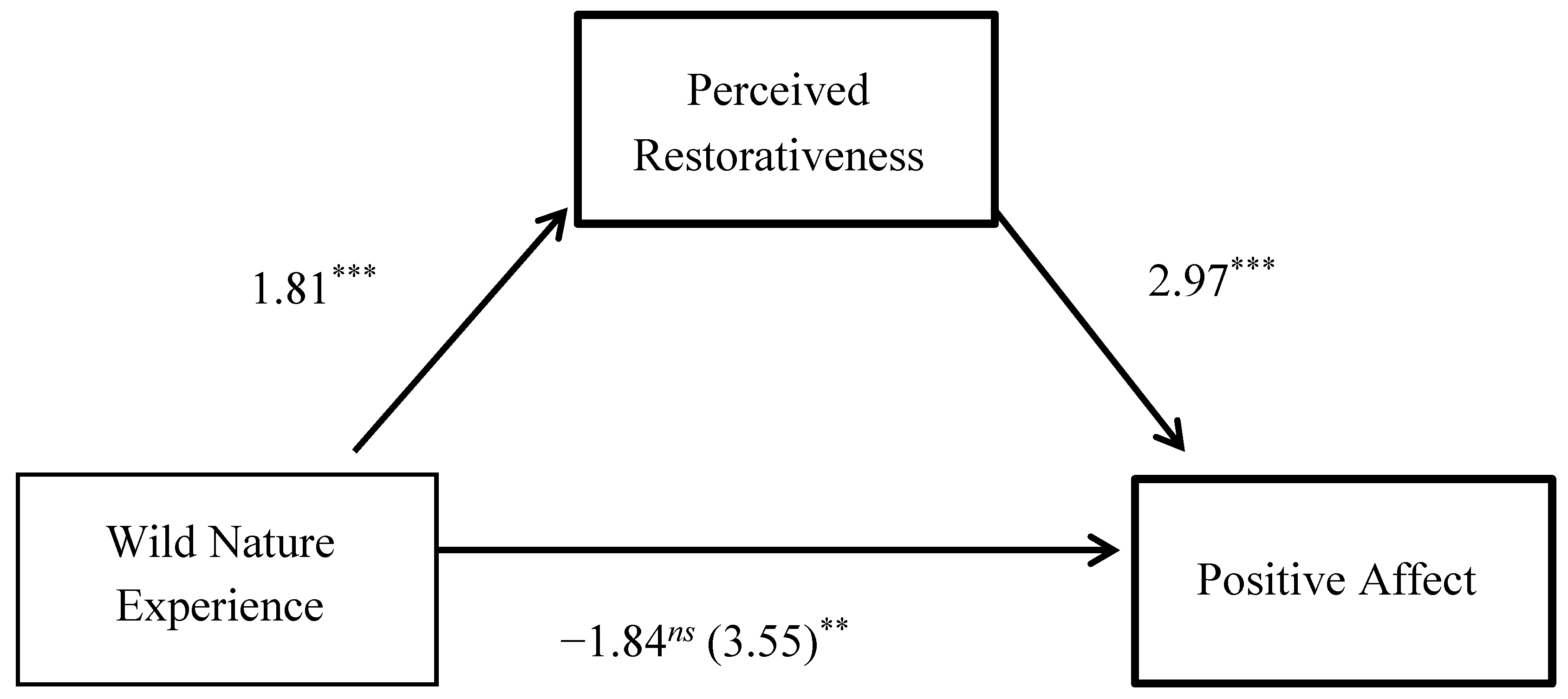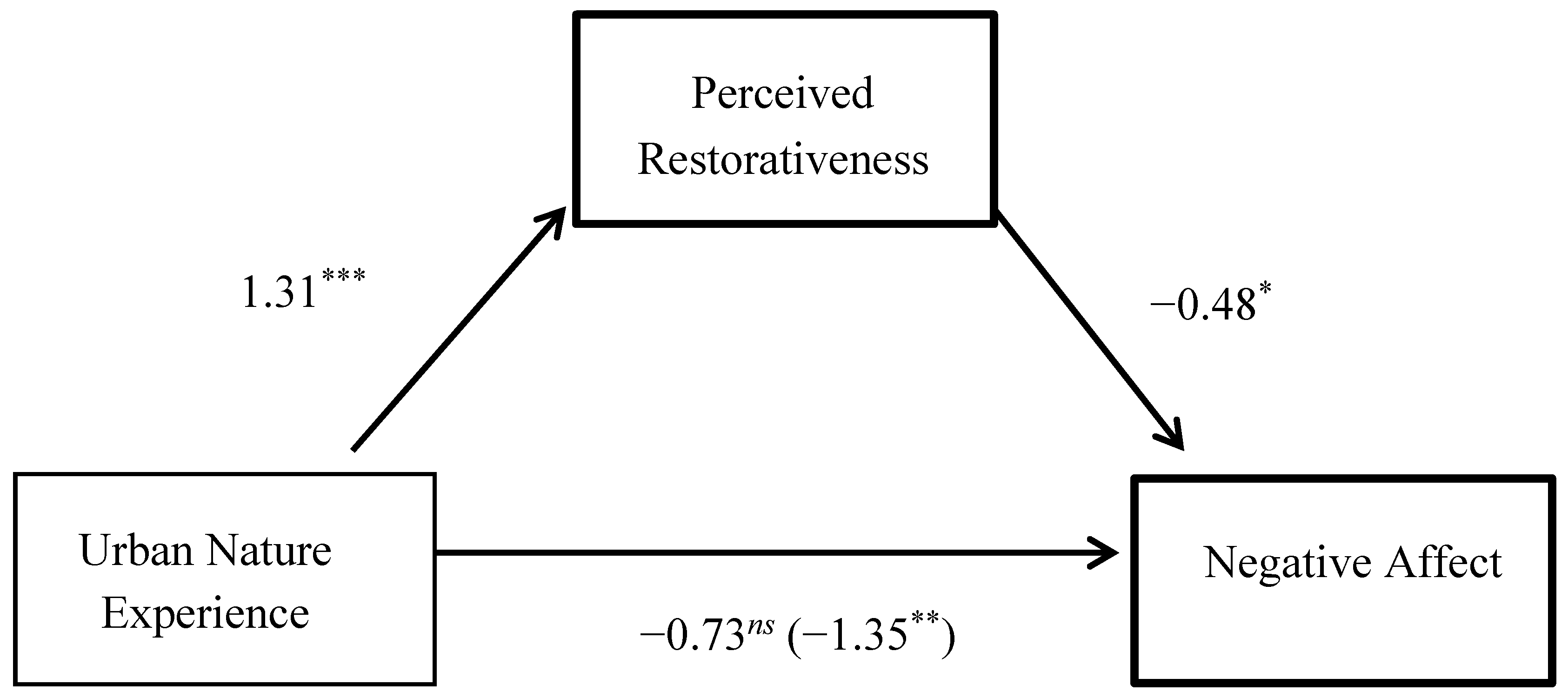Into the Woods or a Stroll in the Park: How Virtual Contact with Nature Impacts Positive and Negative Affect
Abstract
:1. Introduction
1.1. Contact with Nature
1.2. Relationship between Contact with Nature and Affect
1.3. Relationship between Contact with Nature and Restorativeness
1.4. The Current Study
2. Method
2.1. Participants and Procedure
2.2. Experimental Manipulation and Design
2.3. Measures
2.3.1. Perceived Restorativeness
2.3.2. Affect
2.3.3. Manipulation Check and Covariate
2.4. Statistical Analyses
3. Results
3.1. Data Screening
3.2. Preliminary Analyses
3.3. Analyses of Covariance (ANCOVAs)
3.4. Mediation Analyses
4. Discussion
4.1. Effects of Contact with Wild and Urban Nature
4.2. Mediation Analyses
4.3. Limitations and Future Research
5. Conclusions
Author Contributions
Conflicts of Interest
Appendix A
References
- Bowler, D.E.; Buyung-Ali, L.M.; Knight, T.M.; Pullin, A.S. A Systematic Review of Evidence for the Added Benefits to Health of Exposure to Natural Environments. BMC Public Health 2010, 10, 456. [Google Scholar] [CrossRef] [PubMed]
- McMahan, E.A.; Estes, D. The Effect of Contact with Natural Environments on Positive and Negative affect: A Meta-Analysis. J. Posit. Psychol. 2015, 10, 507–519. [Google Scholar] [CrossRef]
- Wilson, E.O. Biophilia; Harvard University Press: Cambridge, MA, USA, 1984. [Google Scholar]
- Townsend, M.; Weerasuriya, R. Beyond Blue to Green: The Benefits of Contact with Nature for Mental Health and Well-Being; Beyond Blue Limited: Melbourne, Australia, 2010. [Google Scholar]
- Shanahan, D.F.; Lin, B.B.; Bush, R.; Gaston, K.J.; Dean, J.H.; Barber, E.; Fuller, R.A. Toward Improved Public Health Outcomes from Urban Nature. Am. J. Public Health 2015, 105, 470–477. [Google Scholar] [CrossRef] [PubMed]
- Bratman, G.N.; Hamilton, J.P.; Daily, G.C. The Impacts of Nature Experience on Human Cognitive Function and Mental Health. Ann. N. Y. Acad. Sci. 2012, 1249, 118–136. [Google Scholar] [CrossRef] [PubMed]
- Kaplan, S.; Kaplan, R. The Experience of Nature: A Psychological Perspective; Cambridge University Press: Cambridge, UK, 1989. [Google Scholar]
- Marselle, M.R.; Irvine, K.N.; Lorenzo-Arribas, A.; Warber, S.L. Moving Beyond Green: Exploring the Relationship of Environment Type and Indicators of Perceived Environmental Quality on Emotional Well-being Following Group Walks. Int. J. Environ. Res. Public Health 2015, 12, 106–130. [Google Scholar] [CrossRef] [PubMed]
- Miller, G.T.; Spoolman, S.E. Living in the Environment, 17th ed.; Brooks/Cole: Belmont, CA, USA, 2012. [Google Scholar]
- Hartig, T.; Book, A.; Garvill, J.; Olsson, T.; Garling, T. Environmental Influences on Psychological Restoration. Scand. J. Psychol. 1996, 37, 378–393. [Google Scholar] [CrossRef] [PubMed]
- Mayer, F.S.; Frantz, C.M.; Bruehlman-Senecal, E.; Dolliver, K. Why is Nature Beneficial? The Role of Connectedness to Nature. Environ. Behav. 2009, 41, 607–643. [Google Scholar] [CrossRef]
- MacKerron, G.; Mourato, S. Happiness is Greater in Natural Environments. Glob. Environ. Chang. 2013, 23, 992–1000. [Google Scholar] [CrossRef]
- Ward-Thompson, C.; Roe, J.; Aspinall, P.; Mitchell, R.; Clow, A.; Miller, D. More green space is linked to less stress in deprived communities: Evidence from salivary cortisol patterns. Landsc. Urban Plan. 2012, 105, 221–229. [Google Scholar] [CrossRef]
- Daniel, T. Measuring the Quality of the Natural Environment: A Psychophysical Approach. Am. Psychol. 1990, 45, 633–637. [Google Scholar] [CrossRef]
- Hartig, T.; Korpela, K.; Evans, G.; Garling, T. A Measure of Restorative Quality in Environments. Scand. Hous. Plan. Res. 1997, 14, 175–194. [Google Scholar] [CrossRef]
- Schutte, N.S.; Bhullar, N.; Stilinovic, E.J.; Richardson, K. The Impact of Virtual Environments on Restorativeness and Affect. Ecopsychology 2017, 9, 1–7. [Google Scholar] [CrossRef]
- Valtchanov, D.; Ellard, C. Physiological and Affective Responses to Immersion in Virtual Reality: Effects of Nature and Urban settings. J. Cyberther. Rehabil. 2010, 3, 359–374. [Google Scholar]
- Jorgensen, A.; Gobster, P.H. Shades of Green: Measuring the Ecology of Urban Green Space in the Context of Human Health and Well-being. Nat. Cult. 2010, 5, 338–363. [Google Scholar] [CrossRef]
- Carrus, G.; Scopelliti, M.; Lafortezza, R.; Colangelo, G.; Ferrini, F.; Salbitano, F.; Sanesi, G. Go Greener, Feel Better? The Positive Effects of Biodiversity on the Well-being of Individuals Visiting Urban and Peri-urban Green Areas. Landsc. Urban Plan. 2015, 134, 221–228. [Google Scholar] [CrossRef]
- Dallimer, M.; Irvine, K.N.; Skinner, A.M.J.; Davies, Z.G.; Rouquette, J.R.; Maltby, L.L.; Warren, P.H.; Armsorth, P.R.; Gaston, K.J. Biodiversity and the Feel-Good Factor: Understanding Associations Between Self-reported Human Well-being and Species Richness. Bioscience 2012, 62, 47–55. [Google Scholar] [CrossRef]
- Fuller, R.A.; Irvine, K.N.; Devine-Wright, P.; Warren, P.H.; Gaston, K.J. Psychological Benefits of Greenspace Increase with Biodiversity. Biol. Lett. 2007, 3, 390–394. [Google Scholar] [CrossRef] [PubMed]
- Van den Berg, A.E.; Jorgensen, A.; Wilson, E.R. Evaluating Restoration in Urban Green Spaces: Does Setting Type Make a Difference? Landsc. Urban Plan. 2014, 127, 173–181. [Google Scholar] [CrossRef]
- Berman, M.G.; Kross, E.; Krpan, K.M.; Askren, M.K.; Burson, A.; Deldin, P.J.; Kaplan, S.; Sherdell, L.; Gotlib, I.H.; Jonides, J. Interacting with Nature Improves Cognition and Affect for Individuals with Depression. J. Affect. Disord. 2012, 140, 300–305. [Google Scholar] [CrossRef] [PubMed]
- Kaplan, S. The Restorative Benefits of Nature: Toward an Integrated Framework. J. Environ. Psychol. 1995, 15, 169–182. [Google Scholar] [CrossRef]
- Berto, R. Exposure to Restorative Environments Helps Restore Attentional Capacity. J. Environ. Psychol. 2005, 25, 249–259. [Google Scholar] [CrossRef]
- Hartig, T.; Evans, G.; Jamner, L.; Davis, D.; Gärling, T. Tracking Restoration in Natural and Urban Field Settings. J. Environ. Psychol. 2003, 23, 109–123. [Google Scholar] [CrossRef]
- Laumann, K.; Gärling, T.; Stormark, K.M. Selective Attention and Heart Rate Responses to Natural and Urban Environments. J. Environ. Psychol. 2003, 23, 125–134. [Google Scholar] [CrossRef]
- Lee, K.E.; Williams, K.J.H.; Sargent, L.D.; Williams, N.S.G.; Johnson, K.A. 40-second Green Roof Views Sustain Attention: The Role of Micro-breaks in Attention Restoration. J. Environ. Psychol. 2015, 42, 182–189. [Google Scholar] [CrossRef]
- Hipp, J.A.; Ogunseitan, O.A. Effect of Environmental Conditions on Perceived Psychological Restorativeness of Coastal Parks. J. Environ. Psychol. 2011, 31, 421–429. [Google Scholar] [CrossRef]
- Tyrväinen, L.; Ojala, A.; Korpela, K.; Lanki, T.; Tsunetsugu, Y.; Kagawa, T. The Influence of Urban Green Environments on Stress Relief Measures: A Field Experiment. J. Environ. Psychol. 2014, 38, 1–9. [Google Scholar] [CrossRef]
- Sato, I.; Conner, T. The Quality of Time in Nature: How Fascination Explains and Enhances the Relationship Between Nature Experiences and Daily Affect. Ecopsychology 2013, 5, 197–204. [Google Scholar] [CrossRef]
- Hartmann, P.; Apaolaza-Ibanez, V. Beyond Savanna: An Evolutionary and Environmental Psychology Approach to Behavioral Effects of Nature Scenery in Green Advertising. J. Environ. Psychol. 2010, 30, 119–128. [Google Scholar] [CrossRef]
- Nittono, H.; Fukushima, M.; Yano, A.; Moriya, H. The Power of Kawaii: Viewing Cute Images Promotes a Careful Behavior and Narrows Attentional Focus. PLoS ONE 2012, 7, e46362. [Google Scholar] [CrossRef] [PubMed]
- Saroglou, V.; Buxant, C.; Tilquin, J. Positive Emotions as Leading to Religion and Spirituality. J. Posit. Psychol. 2008, 3, 165–173. [Google Scholar] [CrossRef]
- Hartig, T.; Kaiser, F.G.; Bowler, P.A. Further Development of a Measure of Perceived Environmental Restorativeness; Uppsala Universitet: Uppsala, Sweden, 1997. [Google Scholar]
- Watson, D.; Clark, L.A.; Tellegen, A. Development and Validation of Brief Measures of Positive and Negative Affect: The PANAS Scales. J. Personal. Soc. Psychol. 1988, 54, 1063–1070. [Google Scholar] [CrossRef]
- Watson, D.; Naragon-Gainey, K. On the Specificity of Positive Emotional Dysfunction in Psychopathology: Evidence from the Mood and Anxiety Disorders and Schizophrenia/Schizotypy. Clin. Psychol. Rev. 2010, 30, 839–848. [Google Scholar] [CrossRef] [PubMed]
- Lovibond, S.H.; Lovibond, P.F. Manual for the Depression Anxiety Stress Scales, 2nd ed.; Psychology Foundation: Sydney, Australia, 1995. [Google Scholar]
- Hayes, A.F. Introduction to Mediation, Moderation, and Conditional Process Analysis: A Regression-Based Approach; Guilford Press: New York, NY, USA, 2013. [Google Scholar]
- Crawford, J.R.; Henry, J.D. The Positive and Negative Affect Schedule (PANAS): Construct Validity, Measurement Properties and Normative Data in a Large Non-clinical Sample. Br. J. Clin. Psychol. 2004, 43, 245–265. [Google Scholar] [CrossRef] [PubMed]
- Cohen, J.W. Statistical Power Analysis for the Behavioral Sciences, 2nd ed.; Lawrence Erlbaum Associates: Hillsdale, NJ, USA, 1988. [Google Scholar]
- White, M.; Alcock, I.; Wheeler, B.W.; Depledge, M.H. Would You Be Happier Living in a Greener Urban Area? A Fixed-effects Analysis of Panel Data. Psychol. Sci. 2013, 24, 920–928. [Google Scholar] [CrossRef] [PubMed]
- Brown, D.; Barton, J.; Gladwell, V. Viewing Nature Scenes Positively Affects Recovery of Autonomic Function Following Acute Mental Stress. Environ. Sci. Technol. 2013, 47, 5562–5569. [Google Scholar] [CrossRef] [PubMed]
- Kamitsis, I.; Francis, A.J.P. Spirituality Mediates the Relationship between Engagement with Nature and Psychological Wellbeing. J. Environ. Psychol. 2013, 36, 136–143. [Google Scholar] [CrossRef]
- Han, K.-T. Responses to Six Major Terrestrial Biomes in terms of Scenic Beauty, Preference, and Restorativeness. Environ. Behav. 2007, 39, 529–556. [Google Scholar] [CrossRef]


| Variables | 1 | 2 | 3 | 4 |
|---|---|---|---|---|
| 1. Perceived Restorativeness | - | 0.41 *** | −0.17 * | 0.09 |
| 2. Positive affect | - | −0.09 | −0.19 ** | |
| 3. Negative affect | - | 0.34 *** | ||
| 4. Depressive symptoms | - | |||
| M | 3.42 | 27.43 | 12.04 | 5.66 |
| SD | 1.26 | 8.26 | 2.85 | 6.04 |
| Condition | Positive Affect | Negative Affect | Perceived Restorativeness | |||
|---|---|---|---|---|---|---|
| M | SE | M | SE | M | SE | |
| Wild nature (n = 72) | 29.92 a | 0.94 | 11.77 a | 0.31 | 4.18 a | 0.12 |
| Urban nature (n = 76) | 25.88 b | 0.92 | 11.51 a | 0.30 | 3.69 b | 0.11 |
| Non-nature control (n = 72) | 26.58 b | 0.94 | 12.87 b | 0.31 | 2.38 c | 0.12 |
© 2017 by the authors. Licensee MDPI, Basel, Switzerland. This article is an open access article distributed under the terms and conditions of the Creative Commons Attribution (CC BY) license (http://creativecommons.org/licenses/by/4.0/).
Share and Cite
McAllister, E.; Bhullar, N.; Schutte, N.S. Into the Woods or a Stroll in the Park: How Virtual Contact with Nature Impacts Positive and Negative Affect. Int. J. Environ. Res. Public Health 2017, 14, 786. https://doi.org/10.3390/ijerph14070786
McAllister E, Bhullar N, Schutte NS. Into the Woods or a Stroll in the Park: How Virtual Contact with Nature Impacts Positive and Negative Affect. International Journal of Environmental Research and Public Health. 2017; 14(7):786. https://doi.org/10.3390/ijerph14070786
Chicago/Turabian StyleMcAllister, Elizabeth, Navjot Bhullar, and Nicola S. Schutte. 2017. "Into the Woods or a Stroll in the Park: How Virtual Contact with Nature Impacts Positive and Negative Affect" International Journal of Environmental Research and Public Health 14, no. 7: 786. https://doi.org/10.3390/ijerph14070786





